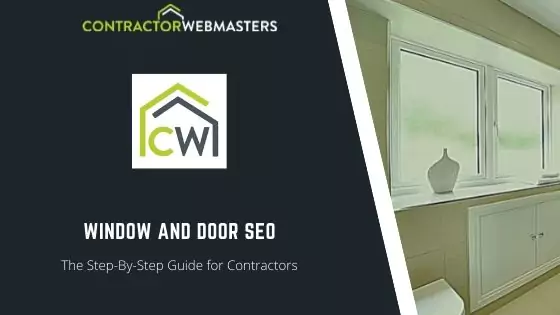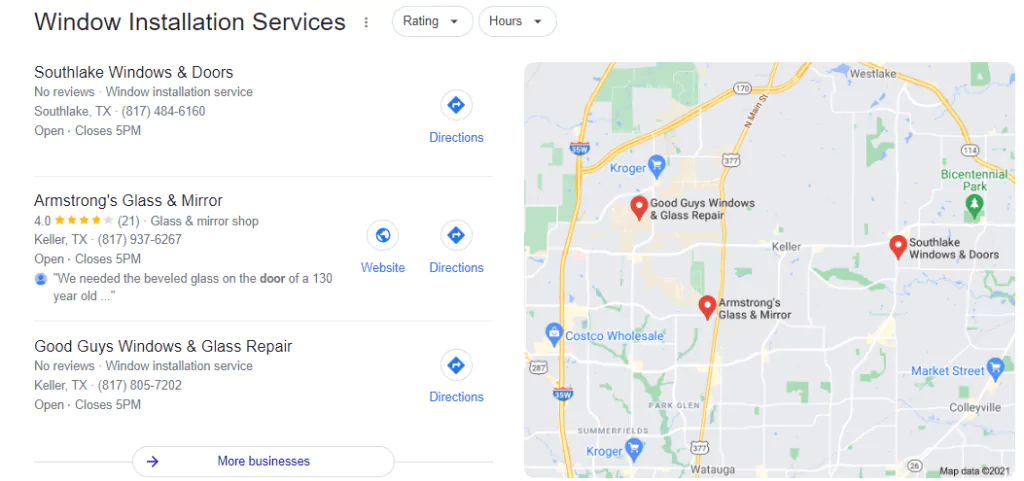SEO for window and door companies is not as widely discussed as in some other industries.
When it comes to window and door SEO, you must ask yourself one crucial question: can your target customers find you online? If the answer is no, search engine optimization is an excellent solution.
Investing in window and door SEO services gives your company more visibility, better leads, and higher online conversion rates.
As an agency that’s worked with various window and door companies throughout the United States, we’ve developed a guide to help businesses learn the essentials of SEO for window and door companies.

Step 1: Audit your Website
Your website is your most powerful marketing tool, and the foundation of your SEO campaign is a window and door company.
A domain name with hosting and indexing feeds other digital marketing endeavors and claims internet real estate.
With that in mind, it is vital to audit your existing website (if you have one) to identify strengths, weaknesses, and areas for improvement.

For example:
- Is your website indexed on Google?
- Does your site appear appropriately on mobile devices?
- Are your website pages targeting the proper user intent?
A professional website audit may serve you well for complex issues. Still, there are things you can audit now to assess your website’s current functionality.
Here are some of the basic web design principles to consider:
Site Structure
Your website should present information in as few clicks as possible. On average, a person spends 54 seconds on any website before clicking through to another one.
Create parent pages and child pages to represent primary services and sub-topics. You will outline your structure based on keyword research.
Ultimately, your website must clearly offer information, phone numbers, services, service areas, etc.
Speed and Security
If your website takes forever to load, customers won’t wait around. As a result, your website should be fast and have an SSL certificate.
If you’ve ever landed on a non-secure website, your browser showcased a warning message, resulting in you exiting the site immediately.
Nobody wants viruses on their computer, and a massive warning sign blocking your website is the fastest way to prevent consistent visitors.
Keyword Targets
Your on-page website content should include keywords that will help improve your rankings. Start by researching keywords to determine which keywords people use to search for your services.
The term or phrase is insufficient to understand the keyword because you must also identify its user intent. Tools like SEMRush will suggest the user intent of keywords to help you save time.
Add those keywords to your written content strategy after defining the commercial or informational intent.
Often, pages cannibalize each other for the same keywords and phrases. Therefore, it is crucial to optimize your keyword targeting by assigning a group of keywords to a specific page or blog post.
Step 2: Off-Site Optimization
Once your own website is in order, it’s time to establish your company across the World Wide Web. Off-site optimization helps drive traffic to your website and shows essential online signals for your business.
With a litany of digital platforms capturing the eyes of potential customers, staking your claim on popular directories and social media networks helps spark brand awareness while strengthing your website.
Link Building
Window and door websites need backlinks to rank on Google search. There are two primary types of backlinks: follow and nofollow.
Nofollow backlinks come from directories and social media profiles, while follow backlinks come from other independent websites.
For local businesses, nofollow links can help optimize your website. However, follow links hold more value because Google views them as endorsements rather than merely ranking hints.
You can earn more links by performing email outreach, ranking for industry terms (especially data and statistical-driven), and immersing yourself in your local and industry communities (offline).
Contact your suppliers and ask them to include a link to your site. Do the same for any professional clubs or networks you may be a part of.
Remember to claim your business on all relevant review websites like Angi, Yelp, and Houzz.
Social Media
Social media is also a powerful tool for window and door SEO. Post fresh content at least twice weekly. Facebook, Instagram, TikTok, and YouTube are essential networks.
Be sure to link to your website from each of your social profiles. With YouTube embeds, You can also use YouTube videos directly on your primary website.
WordPress simplifies embedding a YouTube video onto a web page or blog post.
Facebook is one of the most important social media platforms for window and door companies because it also serves as a review website.
Users can leave Facebook Recommendations for your business, which shed positive or negative light on your company.
Email Marketing
Email is one of window and door contractors’ most underrated digital marketing platforms. You can strengthen your SEO efforts by remarketing to website visitors via email blasts.
Ensure you capture emails on your website by providing a value proposition and lead magnet. For example, a pop-up offers a free discount code in exchange for the visitor’s email address.
Once you have their email, you can send them blog posts and offers, which increases website traffic.
As you craft campaigns for your email list, try developing email content specific to the service the recipient paid for or was asking about.
Email marketing tools like AWeber allow you to segment subscribers into different categories for hyper-targeting.
Step 3: Local Optimization
Local SEO is an off-site SEO element that deserves a singular focus. Window and door companies will garner most of their traffic from local users, ultimately producing the best leads and potential customers.
Google presents a SERP feature called the Local 3-Pack for location-specific queries like door repair near me or window repair near me.
The 3-Pack showcases three Google Business Profile listings that meet the searcher’s need based on relevance, prominence, and proximity.

Google Business Profile
Local SEO for window and door businesses stems from Google Business Profile (formerly Google My Business). You cannot even rank in the Map Pack without a GBP, so claiming and optimizing your profile is essential.
Once you claim your Google listing, optimizing it with accurate contact information, high-quality images, and a link to your primary website is crucial. You can even add FAQ answers and publish Google Posts.
Finally, generating consistent Google reviews helps build prominence for your business profile. When users submit reviews with keywords like door repair, you have a better chance to rank locally.
NAP Citations
Google Business Profile is the most critical citation but one of many that window and door contractors should join. Consider platforms like Yelp, Angi, Houzz, and HomeAdvisor as other options for your business.
Showcasing consistent contact information is vital for digital uniformity and SEO in general. Of course, you always want accurate contact information if a user attempts to contact you through a 3rd-party platform.
Most online directories allow users to provide feedback, making monitoring each of your citations essential. Remember, each website URL link serves as a nofollow backlink to your primary website, so the more citations, the better.
Reviews / Reputation Management
Getting your customers to submit a digital review can be challenging, especially for older clients. Therefore, investing in a reputation management tool like DataPins is crucial, as it sends automated review requests with direct links to the review page.
Reviews are the most critical element of your online reputation but not the only factor. Social proof is another consideration when establishing online credibility. Showcasing badges and awards on your website is an excellent example of social proof.
Finally, city and location pages are crucial for expanding reputation through various service areas. For example, your company may have a strong presence in Seattle, WA, but getting feedback from Spokane can help widen your sphere of influence.
Step 4: Content Marketing
There’s a saying in the SEO industry: content is king. Every aspect of your SEO campaign will require high-quality content from your website to your Facebook business page.
The key is producing consistent, quality content to distribute across various platforms, which drives traffic to your website and earns your business more leads.
One factor to consider is that excess content like blog posts can be a ranking deterrent rather than an asset. As a result, you must focus on content quality over quantity.
Website Content
Your website primarily features pages and posts that call for different content pieces. For example, a service page should be about 700 words and attempt to convert website visitors with strategically placed CTAs.
Conversely, a blog post will represent a different part of your marketing funnel and provide long-form content around an informational query. For example, how to install replacement windows calls for a step-by-step guide.
While informational queries are less likely to produce immediate sales, they enter the user into a long-term funnel to exchange their email address for a content asset. Even if someone thinks they can manually install Windows, they will likely need your help eventually.
AI Content
Google has inserted AI into its search results with AI Overviews, which uses its Larage Langauge Model (Google Gemini) to generate answers based on web data.
Local consumers also use other AI platforms like ChatGPT to find information about local window and door businesses.
Considering this advancement, creating content that AI models find credible is essential to a modern SEO strategy.
Avoid generating your service pages, city pages, or blog posts with ChatGPT, as it will simply regurgitate information it has already been trained on.
To impress AI and Google, you must provide original content with E-E-A-T, which stands for expertise, experience, authority, and trust.
Produce content with images of your jobs and text demonstrating your unique expertise in the door and window industry.
Email Content
Email campaigns often require a specific content style that appeals to email subscribers. Unlike long-form website blog posts, the best emails are short and easy to consume.
Emails should also focus primarily on conversions as the subscriber has already demonstrated previous interest in your services. Offering a discount or promotion with a contact button is an excellent way to get leads.
Remember, segmentation is crucial with email lists. As a result, you will want to craft specific content for particular groups. For example, you can separate email content by demographics like age, region, and particular interests.
Final Thoughts on Window and Door SEO
Window and Door SEO is the most efficient way to generate leads for your business. Claiming and optimizing your Google Business Profile can foster consistent, high-quality leads from search engines.
However, your SEO foundation lies in the quality of your business website, which requires a positive user experience and a detailed keyword strategy.
While short-term lead generation methods like paid ads and shared lead services can give contractors a temporary dopamine hit, SEO is a sustainable strategy that produces low-cost leads for window and door companies.


